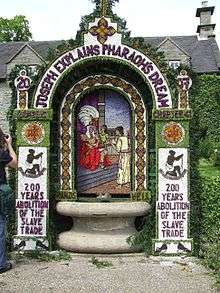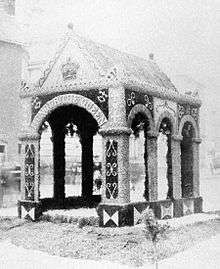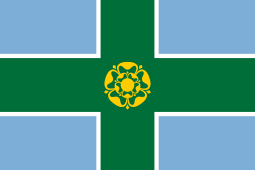Well dressing

Well dressing (also once known as well flowering) is a summer custom practised in rural England in which wells, springs or other water sources are decorated with designs created from flower petals. The custom is most closely associated with the Peak District of Derbyshire and Staffordshire.[1][2]
History
The location identified most closely with well dressing is Tissington in Derbyshire, though the origins of the tradition are obscure. It probably began as a pagan custom of offering thanks to gods for a reliable water supply, though other suggested explanations include villagers celebrating the purity of their water supply after surviving the Black Death in 1348, or alternatively celebrating their water's constancy during a prolonged drought in 1615.[3]

Well dressing was celebrated in only one or two villages in Derbyshire by the 19th century, and in Buxton it wasn't introduced until 1840, "to commemorate the beneficence of the Duke of Devonshire who, at his own expense, made arrangements for supplying the Upper Town, which had been much inconvenienced by the distance to St Anne's well on the Wye, with a fountain of excellent water within easy reach of all".[5] Similarly, well dressing was revived at this time in Youlgreave, to celebrate the supplying of water to the village "from a hill at some distance, by means of pipes laid under the stream of an intervening valley", largely due to the support of a "Miss Bowman". [6] With the arrival of piped water the tradition was adapted so that, not only wells but also taps were decorated, although the resulting creations were still advertised as well dressings.[4]
According to William Hone, writing in 1835:
Rhodes, who has traversed almost every part of the peak with indefatigable zeal, gives the following account in his Peak Scenery. "An ancient custom still prevails in the village of Tissington, to which indeed it appears to be confined, for I have not met with any thing of a similar description in any other part of Derbyshire. It is denominated well-flowering, and Holy Thursday is devoted to the rites and ceremonies of this elegant custom. The day is regarded as a festival; and all the wells in the place, five in number, are decorated with wreaths and garlands of newly-gathered flowers, disposed in various devices. Sometimes boards are used, which are cut to the figure intended to be represented, and covered with moist clay into which the stems of the flowers are inserted to preserve their freshness; and they are so arranged to form a beautiful mosaic work, often tasteful in design, and vivid in colouring; the boards thus adorned are placed in the spring, that the water appears to issue from among the beds of flowers. On this occasion the villagers put on their best attire and open their houses to their friends. There is a service at the church, where a sermon is preached: afterwards a procession takes place, and the wells are visited in succession: the psalms for the day, the epistle and gospel are read, one at each well, and the whole concludes with a hymn which is sung by the church singers, and accompanied by a band of music. This done they separate, and the remainder of the day is spent in rural sports and pastimes."[7]
The custom waxed and waned over the years. In the 1930s the Shimwell family, later of Tideswell, did much to help revival; Crichton Porteus wrote of Stoney Middleton, "The well-dressing was begun in 1936, mainly through the influence of a new schoolmaster, Mr. Oliver Shinwell (sic), member of a well-known family of Youlgreave dressers. Mr. Shimwell later went to Tideswell, where he has helped with a further revival" from 1946.[8] However, that book also said that by 1859 Tissington "well-dressing was established and important once more" and mentions dressing at Wirksworth in 1860 and a Maypole there in 1914. It also refers to breaks in dressing at Youlgreave (1849–69), Buxton (1912–24), Derby (1919–46), Bonsall (c1928-35) and in most dressing during the 1939-45 war.

The custom has since been revived in numerous villages and small towns in Derbyshire, Staffordshire, South Yorkshire, Cheshire,[9] and even as far afield as Much Wenlock in Shropshire and Malvern in Worcester.[10] Another boost to the tradition was the Festival of Britain; in villages like Wormhill where the custom appears to have ceased in the late 18th century, it was revived as part of the Festival of Britain, and has continued nearly every year since.[11]
A tradition of well dressing in the Malverns dates from the 12th and 13th centuries when around 5 August each year, tribute was paid to St Oswald for water cures. The tradition of well dressing continues, fostered by interest groups and activities such as arts projects.[12]
In 2011 well dressing was introduced to the village of Kemsing in Kent. The 2014 well dressing (right) commemorates World War I.
In fiction
John Brunner's story "In the Season of the Dressing of the Wells" describes the revival of the custom in an English village of the West Country after World War I and its connection to the Goddess.[13][14]
Process

Wooden frames are constructed and covered with clay, mixed with water and salt. A design is sketched on paper, often of a religious theme, and this is traced onto the clay. The picture is then filled in with natural materials, predominantly flower petals and mosses, but also beans, seeds and small cones. Each group uses its own technique, with some areas mandating that only natural materials be used while others feel free to use modern materials to simplify production. Wirksworth and Barlow are two of the very few dressings where the strict use of only natural materials is still observed.
See also
Notes
- ↑ Well Dressing, Historic-UK, accessed August 2009.
- ↑ Well Dressing History, Buxton & Derbyshire Peakdistrict, accessed August 2009.
- ↑ Christian, Roy (1976). The Peak District. British Topographical Series. David & Charles. pp. 206–7. ISBN 0-7153-7094-4.
- 1 2 1860s picture, PictureThePast, accessed August 2009.
- ↑ Anon (28 April 1858). "Buxton well dressing of 1856". The Derby Mercury. Derby, UK.
- ↑ Anon (10 August 1842). "Well dressing". The Derby Mercury. Derby, UK.
- ↑ Hone, William (1835). The Every-day book and Table book: or, Everlasting calendar of popular amusements, sports, pastimes, ceremonies, manners, customs and events. pp. 638–9. Retrieved 20 April 2010.
- ↑ The beauty and mystery of well dressing: Crichton Porteus 1949 Pilgrim Press
- ↑ Well dressing in Sutton, Cheshire.
- ↑ , Malvern Spa Association].
- ↑ Anon (2008). "The History of Well Dressing". Hargate Hall website. Hargate Hall Ltd. Retrieved 20 April 2010.
- ↑ Malvern Hills: well dressing Malvern Well Dressing History Check
|url=value (help), Malvern Spa Association, retrieved 12 July 2010 - ↑ "After the King". Tolkien Gateway. Retrieved 31 December 2013.
- ↑ Martin H. Greenberg, ed. (1992). After the King: Stories In Honor of J.R.R. Tolkien. New York: Tor. pp. 106–150. ISBN 0312851758. Retrieved 31 December 2013.
References
- Well dressing WS (annually updated with a diary of well dressings)
- Guide to the production of a well dressing Archived 27 October 2005 at the Wayback Machine.
External links
| Wikimedia Commons has media related to Well dressing. |
- Official website for the Stoney Middleton Well Dressing Committee
- Official website of the Buxton Wells Dressing Festival
- Short history of well dressing
- Tissington Hall's guide to producing welldressings
- Well dressings in Wirksworth Derbyshire Archived 5 June 2008 at the Wayback Machine.
- Community site for Wirksworth Derbyshire
- Well Dressings in Barlow, Derbyshire. Dressed year on year for at least 150 years
- A history of well dressing in Wormhill
- Well dressings in Brackenfield
